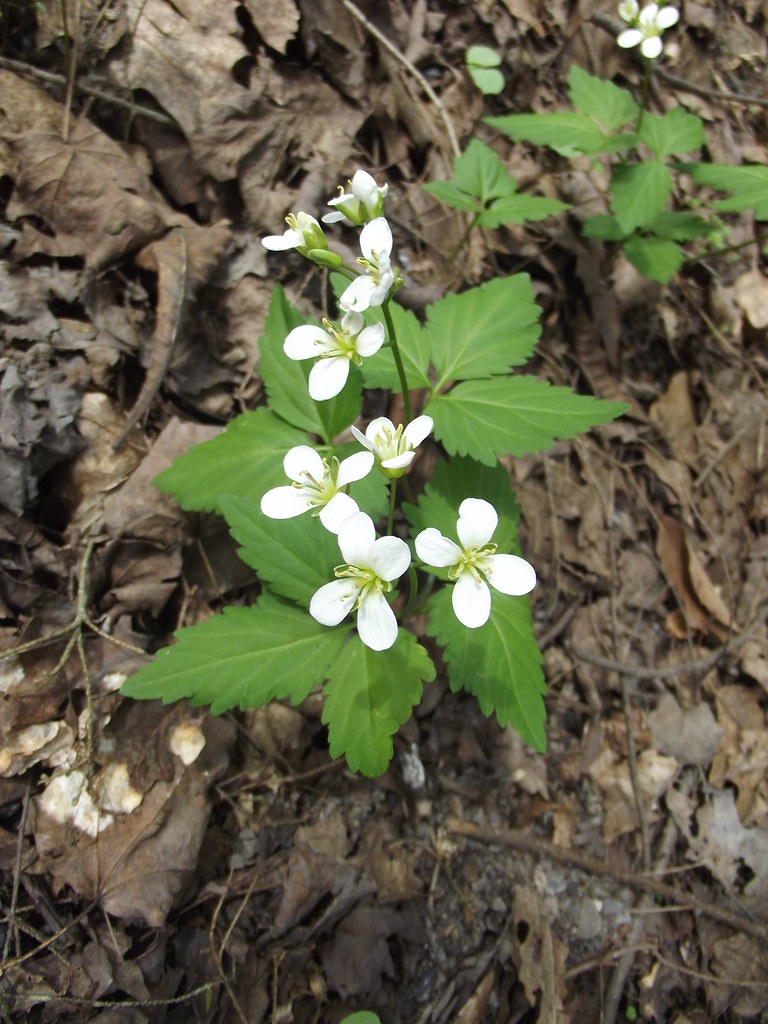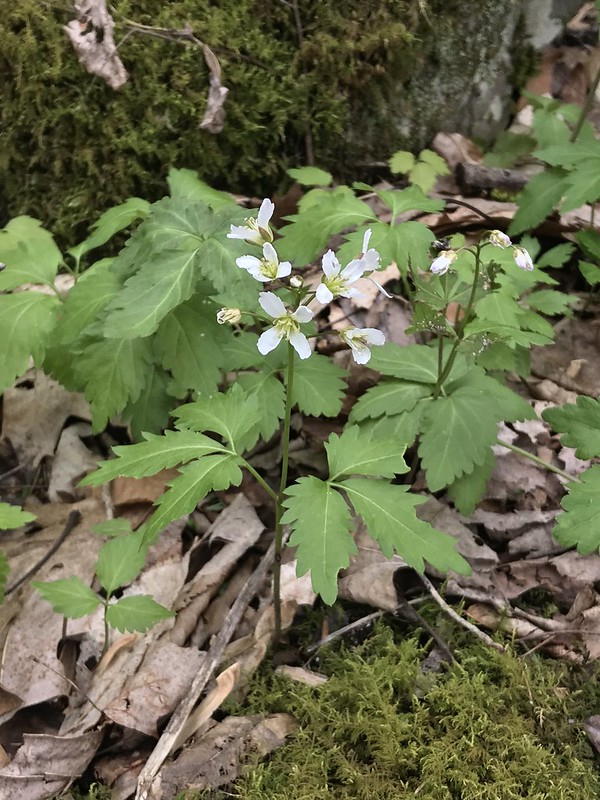Map Snapshot



48 Records
Status
Broad-leaved Toothwort is uncommon on the Allegheny Plateau of Garrett County, and becomes rare in the Ridge and Valley and Piedmont. Broad-leaved Toothwort is found in rich mesic forests.
Description
Broad-leaved Toothwort is very similar to Slender Toothwort and Cut-leaved Toothwort. Broad-leaved Toothwort can be differentiated from Cut-leaved Toothwort by having basal leaves while in bloom. Cut-leaved Toothwort typically lacks basal leaves while in bloom. Slender Toothwort and Broad-leaved Toothwort are very similar in appearance. The best way to differentiate between these two species is to look at the stem (cauline) leaves. The cauline leaves of Broad-leaved Toothwort are similar in width to the basal leaves, while the cauline leaves of Slender Toothwort are much narrower than the basal leaves.
It is very important when documenting Broad-leaved Toothwort that the cauline leaves are well represented.
Seasonality Snapshot
Source: Wikipedia
| Cardamine diphylla | |
|---|---|

| |
| Scientific classification | |
| Kingdom: | Plantae |
| Clade: | Tracheophytes |
| Clade: | Angiosperms |
| Clade: | Eudicots |
| Clade: | Rosids |
| Order: | Brassicales |
| Family: | Brassicaceae |
| Genus: | Cardamine |
| Species: | C. diphylla
|
| Binomial name | |
| Cardamine diphylla | |
| Synonyms[3] | |
|
Homotypic Synonyms
Heterotypic Synonyms
| |
Cardamine diphylla (broadleaf toothwort, crinkle root, crinkle-root, crinkleroot, pepper root, twin-leaved toothwort, twoleaf toothwort, toothwort) is a flowering plant in the family Brassicaceae. It is a spring flowering woodland plant that is native to eastern North America.
Description
[edit]
A member of the mustard family, it is typified by a four petal flower which blooms in a cluster on a single stalk above a single pair of toothed stem leaves each divided into three broad leaflets. After flowering, narrow seedpods appear just below the flower cluster. It grows approximately 30 cm (12 in) tall.[citation needed]
Taxonomy
[edit]Cardamine diphylla was first described as Dentaria diphylla by the French botanist André Michaux in 1803.[4][5] The American botanist Alphonso Wood placed Dentaria diphylla Michx. in genus Cardamine in 1870.[2][6] The name Cardamine diphylla (Michx.) Alph.Wood is widely used today.[3][7]
Cardamine diphylla is a member of the Cardamine concatenata alliance, a monophyletic group of eastern North American species that includes Cardamine angustata, Cardamine concatenata, Cardamine diphylla, Cardamine dissecta, Cardamine incisa, and Cardamine maxima.[8] All members of the alliance were previously placed in genus Dentaria Tourn. ex L., which is now considered to be a synonym for Cardamine L.[9]
Distribution and habitat
[edit]Cardamine diphylla is native to eastern North America. Its wide range extends north to Québec and Nova Scotia, south to Georgia and Alabama, and west to Wisconsin.[8] It is known to occur in the following provinces and states:[3][10]
- Canada: New Brunswick, Nova Scotia, Ontario, Québec
- United States: Alabama, Arkansas, Connecticut, Georgia, Indiana, Kentucky, Maine, Maryland, Massachusetts, Michigan, Minnesota, New Hampshire, New Jersey, New York, North Carolina, Ohio, Pennsylvania, South Carolina, Tennessee, Vermont, Virginia, West Virginia, Wisconsin
Its distribution is centered in the Great Lakes region of North America.[11] It is found in moist woodlands usually in edge habitats and blooms from April to June.[12]
Ecology
[edit]The West Virginia white butterfly (Pieris virginiensis) lays its eggs on this plant as well as C. laciniata. The larvae also feed on this plant.[13] As with Pieris oleracea, Pieris virginiensis mistakes garlic mustard for its host plants, making eradication of it important for their continued survival. Garlic mustard also competes with the plants for space and nutrients.[14]
Conservation
[edit]The global conservation status of Cardamine diphylla is secure (G5).[1]
Uses
[edit]Medicinal
[edit]The ground root is mixed with vinegar by the Algonquin people of Quebec and used as a relish.[15] They also give an infusion to children to treat fevers, and use an infusion of the plant and sweet flag root to treat heart disease.[16] The Cherokee use a poultice of the root for headaches, chew the root for colds and gargle an infusion for sore throats.[17] The Lenape use the roots as a stomach medicine,[18] and use an infusion of the roots combined with other plants as a treatment for scrofula and venereal disease.[19] The Delaware Nation of Oklahoma use a compound containing the root as a stomach remedy, for scrofula, and for venereal disease.[20]
The Iroquois take an infusion of the whole plant to strengthen the breasts.[21] They also chew the raw root for stomach gas, apply a poultice of roots to swellings, take a cold infusion of the plant for fever and for "summer complaint, drink a cold infusion of the roots for "when love is too strong", and use an infusion of the roots when "heart jumps and the head goes wrong."[22] They also use a compound for chest pains.[23] They also take an infusion of the plant at the beginning of tuberculosis.[24] The Malecite use an infusion of the roots as a tonic,[25] and chew green or dried roots for hoarseness.[26] The Micmac use the root as a sedative, to clear the throat and for hoarseness, and use the root as a tonic.[27]
Culinary
[edit]The Abenaki use it as a condiment.[28] The Cherokee parboil and rinse the stems and leaves, add hot grease, salt & water & boiled them until they are soft as potherbs. They also use the leaves in salads,[29] and smoke the plant.[30] The Iroquois eat the roots raw with salt or boiled.[31] The Ojibwa mix the roots with salt, vinegar, or sugar and use them as a condiment.[32]
References
[edit]- ^ a b "Cardamine diphylla". NatureServe Explorer. NatureServe. Retrieved 10 June 2023.
- ^ a b "Cardamine diphylla (Michx.) Alph.Wood". International Plant Names Index (IPNI). Royal Botanic Gardens, Kew; Harvard University Herbaria & Libraries; Australian National Botanic Gardens. Retrieved 8 June 2023.
- ^ a b c "Cardamine diphylla (Michx.) Alph.Wood". Plants of the World Online. Royal Botanic Gardens, Kew. Retrieved 8 June 2023.
- ^ "Dentaria diphylla Michx.". International Plant Names Index (IPNI). Royal Botanic Gardens, Kew; Harvard University Herbaria & Libraries; Australian National Botanic Gardens. Retrieved 8 June 2023.
- ^ Michaux (1803), p. 30.
- ^ Wood (1889), Part IV, pp. 37–38.
- ^ Al-Shehbaz, Ihsan A.; Marhold, Karol; Lihová, Judita (2010). "Cardamine diphylla". In Flora of North America Editorial Committee (ed.). Flora of North America North of Mexico (FNA). Vol. 7. New York and Oxford: Oxford University Press. Retrieved 7 June 2023 – via eFloras.org, Missouri Botanical Garden, St. Louis, MO & Harvard University Herbaria, Cambridge, MA.
- ^ a b Sweeney, Patrick W.; Price, Robert A. (2001). "A multivariate morphological analysis of the Cardamine concatenata alliance (Brassicaceae)". Brittonia. 53 (1): 82–95. Bibcode:2001Britt..53...82S. doi:10.1007/BF02805400. S2CID 41204861. Retrieved 8 June 2023.
- ^ "Dentaria Tourn. ex L.". Plants of the World Online. Royal Botanic Gardens, Kew. Retrieved 8 June 2023.
- ^ "Cardamine diphylla". State-level distribution map from the North American Plant Atlas (NAPA). Biota of North America Program (BONAP). 2014. Retrieved 10 June 2023.
- ^ "Cardamine diphylla". County-level distribution map from the North American Plant Atlas (NAPA). Biota of North America Program (BONAP). 2014. Retrieved 10 June 2023.
- ^ "Cardamine diphylla (Broad-leaved Toothwort, Crinkleroot, Pepper root, Toothroot, Twin-leaved Toothwort, Two-leaf Toothwort) | North Carolina Extension Gardener Plant Toolbox". plants.ces.ncsu.edu. Retrieved 2021-12-18.
- ^ "Butterflies and Moths of North America". Archived from the original on 2007-02-05. Retrieved 2007-05-13.
- ^ Becker, R., Gerber E., Hinz H., Katovich E., Panke B., Reardon R., Renz R., Van Riper L., 2013. Biology and Biological Control of Garlic Mustard. The Forest Technology Enterprise Team. https://www.fs.fed.us/foresthealth/technology/pdfs/FS_garlicmustard.pdf
- ^ Black, Meredith Jean 1980 Algonquin Ethnobotany: An Interpretation of Aboriginal Adaptation in South Western Quebec. Ottawa. National Museums of Canada. Mercury Series Number 65 (p. 86)
- ^ Black, p.173
- ^ Hamel, Paul B. and Mary U. Chiltoskey 1975 Cherokee Plants and Their Uses -- A 400 Year History. Sylva, N.C. Herald Publishing Co. (p. 59)
- ^ Tantaquidgeon, Gladys 1972 Folk Medicine of the Delaware and Related Algonkian Indians. Harrisburg. Pennsylvania Historical Commission Anthropological Papers #3 (p. 37)
- ^ Tantaquidgeon, p.34
- ^ Tantaquidgeon, p.31, 76
- ^ Rousseau, Jacques 1945 Le Folklore Botanique De Caughnawaga. Contributions de l'Institut botanique l'Université de Montréal 55:7-72 (p. 45)
- ^ Herrick, James William 1977 Iroquois Medical Botany. State University of New York, Albany, PhD Thesis (p. 341)
- ^ Herrick, p.341
- ^ Rousseau, Jacques 1945 Le Folklore Botanique De Caughnawaga. Contributions de l'Institut botanique l'Université de Montréal 55:7-72 (p. 45)
- ^ Mechling, W.H. 1959 The Malecite Indians With Notes on the Micmacs. Anthropologica 8:239-263 (p. 252)
- ^ Mechling p.247, 252
- ^ Chandler, R. Frank, Lois Freeman and Shirley N. Hooper 1979 Herbal Remedies of the Maritime Indians. Journal of Ethnopharmacology 1:49-68 (p. 56)
- ^ Rousseau, Jacques 1947 Ethnobotanique Abénakise. Archives de Folklore 11:145-182 (p. 152)
- ^ Perry, Myra Jean 1975 Food Use of "Wild" Plants by Cherokee Indians. The University of Tennessee, M.S. Thesis (p. 37)
- ^ Hamel, Paul B. and Mary U. Chiltoskey 1975 Cherokee Plants and Their Uses -- A 400 Year History. Sylva, N.C. Herald Publishing Co. (p. 59)
- ^ Waugh, F. W. 1916 Iroquois Foods and Food Preparation. Ottawa. Canada Department of Mines (p. 120)
- ^ Arnason, Thor, Richard J. Hebda and Timothy Johns 1981 Use of Plants for Food and Medicine by Native Peoples of Eastern Canada. Canadian Journal of Botany 59(11):2189-2325 (p. 2207)
Bibliography
[edit]- Gilman, Arthur V. (2015). New Flora of Vermont. Memoirs of The New York Botanical Garden, Volume 110. Bronx, New York, USA: The New York Botanical Garden Press. ISBN 978-0-89327-516-7.
- Haines, Arthur (2011). New England Wild Flower Society's Flora Novae Angliae: A Manual for the Identification of Native and Naturalized Higher Vascular Plants of New England. Illustrated by Elizabeth Farnsworth and Gordon Morrison. Yale University Press. ISBN 978-0-300-17154-9.
- Michaux, André (March 1803). Flora Boreali-Americana. Vol. 2. Paris and Strasbourg. Retrieved 13 June 2023.
- Weakley, Alan S.; Southeastern Flora Team (2022). "Flora of the southeastern United States". University of North Carolina Herbarium, North Carolina Botanical Garden.
- Wood, Alphonso (1889) [First edition 1870]. Willis, Oliver R. (ed.). The New American Botanist and Florist (Revised 8th ed.). New York and Chicago: A. S. Barnes & Company. Retrieved 9 June 2023.
External links
[edit]- USDA Plants Profile: Cardamine diphylla
- Evergreen NPDB, Toothwort
- "Cardamine diphylla — two-leaved toothwort". Go Botany. Native Plant Trust. Retrieved 10 June 2023.
- "Cardamine diphylla (Michaux) Alph.Wood". Flora of the Southeastern United States (2023 Edition). Retrieved 10 June 2023.











